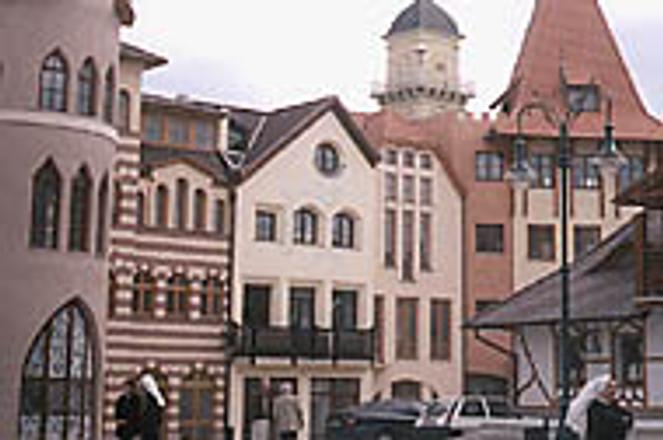Slovakia's southern-most city, Komárno, recently gave its central square a complete overhaul.photo: Zuzana Habšudová
The train from Bratislava passes over the river Váh as it enters Komárno, Slovakia's southernmost city. Since the river is nearly as wide as the Danube, which forms the border in the south between Hungary and Slovakia, a disoriented traveller may think that he has missed his stop and is crossing the Danube into Hungary. Although that hasn't happened, Komárno may still seem like a different world.
Komárno (population 40,000) is one of a handful of cities in southern Slovakia dominated by Slovakia's Hungarian minority (locals say the ratio is 70% Hungarian, 30% Slovak). Signs are in Slovak and Hungarian, Hungarian is the conversation of choice, and restaurants serve spicy Hungarian dishes. Even the landscape - flat farmland stretching out toward more flat farmland - is strikingly different than the rest of mountainous Slovakia.
With a past thick with battles, and an omnipresent bicultural flavour forged in the aftermath of war, history is almost tangible in Komárno. Hungarians fought off the Turks here in the 16th and 17th centuries, rebelled against the Habsburgs in the 19th, and became de facto citizens of the first Czechoslovakia in 1920 when the Treaty of Trianon divided the city in half at the Danube.
Visitors will find a detailed map in front of the train station, which is marked in the middle by a small train icon. The jagged conglomeration to the south-east is Komárno's fetching centre. The upside-down 'U'-shaped trail of bastions (denoted by Roman numerals I - IX) form the northern, eastern, and much of the western city limits, while the Danube defines the city's southern border.
The squat, stone bastions were built into mounds ringing the city when Napoleon was tearing through Europe in the early 19th century; they were later used in 1848 by locals revolting against the Hapsburgs. The revolution was led by Gyorgy Klapka, whose statue in the city centre is decorated with flowers every March 15 by visitors from Hungary.
But Komárno had earned a reputation as a military city long before the bastions were built - Hungarians fought off the Turks for over a century at a fort at the confluence of the Danube and Váh rivers. The Turks burnt much of the town down in 1529 and 1594 but never took the city. (To learn more about battles with the Turks, stop by the Danube Museum in the city centre: Palatinová 13, open Tue-Sat 9:00-16:00.)
The sixth bastion, north-east of the train station, is a good place to begin or end a circle tour (an hour and a half by foot) of the city's fortifications. With a museum (open May to October 10:00 to 17:00 except Mon) and a night club, it is the most inviting of the bastions, and its Restaurant Fortezza, which serves an incomparable cheese onion soup, is reason enough for a visit.
If lost, don't be afraid to ask for help in Slovak or Hungarian. Allegations that the country's Hungarians can't speak Slovak are simply false, at least in Komárno. Almost everyone speaks Slovak fluently, and those who don't can at least give directions in Slovak. For foreigners learning the language, conversing with locals has an advantage: no one in Komárno is irritated by beginner Slovak. Language buffs can win favour among locals by mastering a few Hungarian phrases (see chart).
Komárno's centre is easily located by the twin towers of the baroque church, across from the Danube Museum on Palatinová street. A Visitor Centre nearby on Župna 5 offers maps of the city and suggestions on where to spend the night. The centre's main sites include the baroque church, the Serb orthodox church (Palatinová 32), with an exhibition of sacral monuments, and Gyorgy Klapka square, where a figurine emerges from a building every day at 10:00 and 16:00 to the tune of a Hungarian march.
The bridge across the Danube connects Komárno to Komárom, Hungary. To save around 10 dollars when travelling by train from Bratislava to Budapest, buy a ticket only to Komárno, walk through town, cross the bridge, turn right and buy a ticket from the Komárom train station to Budapest.
Komárom is a dull, centreless border town, but it does have something Komárno, with its harbour and shipyard, doesn't have: an unobstructed view of the Danube. On a clear night or sunny afternoon, recline on the riverbank in Komárom and watch the ships cruise up and down the Danube past Komárno, where wars were waged and the fates of nations decided.
Hungarians migrated from Asia to central Europe in the late 800s. Their language bears no relation to those of their Slavic, Austrian and Romanian neighbours. It's only European relative is Finnish.
Some words and simple phrases, followed by pronunciation:
Igen - yes (ee-gen)
Nem - no (nem)
Szia - hello/goodbye (see-ya)
Beszél angolul? - Do you speak English? (bay- sail un-go-lool)
Jónapot kivánok - good day/hello (yo-na-poat key-von-oak)
Köszönöm - Thank you (Kuh-suh-nem)
Tessék - Here you go (tesh-eek)
Viszontlátasra - See you later (vis-soant-lah-tosh-ra)
Egészségedre- Cheers (egg-esh-shea-ge-dre)
Jóétvagyat - Bon appetite (jo-et-va-dyat)
Hogy vagy? - How are you? (hod vad, both soft on end)
Jól - Good (yoal)
Kérem- Please (key-rem)
Compiled by
Matthew J. Reynolds and Timotej Kelecsényi
A more complete version of this article will be published this summer in The Slovak Spectator's sixth annual travel guide Spectacular Slovakia 2001. Leading up to the magazine's publication, travel stories will be printed in this space over the following weeks.
To pre-order copies of this year's Spectacular Slovakia, contact Ján Svrček at 07 5923 3302, or e-mail him at jan.svrcek@spectator.gpp.sk.
To book advertising space, please contact Raluca Benko at 07 5923 3225, or at slspect@gpp.sk.


